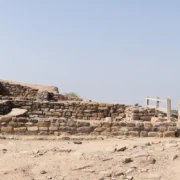The Mysteries of Dholavira: Insights into an Ancient Marvel
Dholavira, a crown jewel of the Indus Valley Civilization, is nestled in Gujarat’s desert landscape. Thriving from 3000-1500 BCE on Khadir Island, this ancient city is celebrated for its urban planning and advanced resource management. A symbol of human resilience and architectural ingenuity, Dholavira’s legacy is immortalised through its remarkable artefacts and sophisticated societal structure.
In this blog, we will delve into the fascinating world of Dholavira, exploring its significance in the Indus Valley Civilization, the architectural marvels that define its landscape, and the intriguing story of its rise, flourishing, and eventual decline.
Join us as we journey back in time to uncover the secrets of one of the most remarkable cities of ancient India, piecing together the remnants of a civilization that continues to captivate historians and archaeologists alike.

Dholavira as a Hub of Ancient Trade
The significance of Dholavira in the Indus Valley Civilization extends beyond its architectural splendour to its pivotal role in ancient commerce. Ideally positioned on the trade routes, Dholavira was a vital link between the Indus Valley Civilization and other ancient empires in Mesopotamia and Central Asia. This commercial hub, bustling with activity, facilitated the exchange of ideas, goods, and culture. Archaeological evidence suggests a city flourishing with trade, where local products like pottery and textiles were exchanged for exotic goods from distant lands, underlining its role as a cornerstone in the economic dynamics of the period.

The Cultural Imprint of Dholavira
The cultural landscape of Dholavira, a world heritage site, was as rich as its economic prowess. As a melting pot of various cultures, the city was a cradle of artistic and religious expressions. The artefacts found, including intricately painted pottery and expertly crafted tools and ornaments, speak volumes about the artistic and technological skills of its inhabitants. These cultural relics paint a vivid picture of a society deeply embedded in its traditions, beliefs, and practices, highlighting a civilization that was not only advanced in its material accomplishments but also in its cultural and artistic achievements.

Dholavira’s Architectural and Artistic Mastery
The archaeological excavations at Dholavira, initiated in 1989 by the Archaeological Survey of India, have unveiled a city of remarkable urban planning and rich cultural heritage. Dholavira’s layout was meticulously designed, comprising a citadel, middle town, and lower town, each displaying unique architectural features and a clear hierarchical structure. The city was distinguished by its use of stone for construction, unlike other Harappan sites predominantly built of bricks.
Evoke Dholavira: A Luxurious Retreat
In addition to its structural marvels, Dholavira has yielded a wealth of artefacts that shed light on the daily lives and skills of its inhabitants. Among the discoveries are painted Indus black-on-red-ware pottery, square stamp seals, a significant signboard inscribed with the Indus script, and various metal and stone objects showcasing the community’s craftsmanship. These artefacts include tools, ornaments, and domestic utensils, providing a glimpse into the city’s advanced technological and artistic achievements. The finding of stone weights suggests a complex system of trade and measurement.
This rich tapestry of archaeological findings not only illustrates Dholavira’s prominence in the Indus Valley Civilization but also its significant contribution to the understanding of early urban settlements and their complex societal structures.
The Decline and Fall of Dholavira
The fall of Dholavira, a significant city in the Indus Valley Civilization, is a subject enveloped in mystery. Archaeological studies, including excavations conducted by the Archaeological Survey of India, have revealed that Dholavira went through seven stages, from its development to maturity and eventually to its decline. The decline, observed in the fifth stage, was marked by a temporary abandonment of the city. When settlers returned in the late Harappan stage, there was a notable shift in their lifestyle.
The culture became markedly de-urbanized, with changes in pottery styles influenced by regions like Sindh, South Rajasthan, and other parts of Gujarat. The return did not signal a revival of the once-glorious civilization; instead, there was a simplification of life, indicating a conscious adaptation to changing circumstances. The transformation in their dwellings, from sophisticated urban structures to simpler circular houses, and the noticeable shift in material culture suggest a society preparing for a gradual end, perhaps in response to environmental or socio-economic challenges.
The Enduring Legacy of Dholavira
Today, as a World Heritage Site, Dholavira not only symbolises the grandeur of the Indus Valley Civilization but also serves as a crucial link to our past. The preservation and study of Dholavira offer insights into our history and heritage, emphasising the importance of learning from bygone eras.
Evoke Dholavira, blending historical exploration with modern comfort, invites guests to experience the legacy of this ancient city, where the echoes of a once-thriving civilization resonate amidst contemporary amenities and hospitality.
Book your stay at Evoke Dholavira (insert website link), and embark on a journey that bridges the past with the present.





